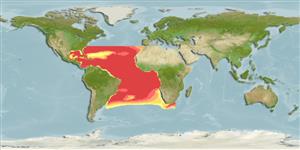Teleostei (teleosts) >
Stomiiformes (Lightfishes and dragonfishes) >
Gonostomatidae (Bristlemouths)
Etymology: Manducus: Latin, manducare = to chew (Ref. 45335).
Environment: milieu / climate zone / depth range / distribution range
Ecology
Marine; bathypelagic; depth range 0 - 850 m (Ref. 13608), usually 400 - 800 m (Ref. 47377). Deep-water; 35°N -
Eastern Atlantic: Senegal, Madeira, and Cape Verde; off southern Africa, ca. 19°S, 5°W (Ref. 3991). Western Atlantic: eastern coast of the United States, Bahamas, Straits of Florida, Gulf of Mexico, Suriname, and Brazil (Ref. 37039).
Size / Weight / Age
Maturity: Lm ? range ? - ? cm
Max length : 27.9 cm SL male/unsexed; (Ref. 37039)
Exhibits diel vertical migrations (Ref. 4769); found between 400-800 m during the day and near the surface at night (Ref. 3991).
Life cycle and mating behavior
Maturity | Reproduction | Spawning | Eggs | Fecundity | Larvae
Quéro, J.-C., J.C. Njock and M.M. de la Hoz, 1990. Gonostomatidae. p. 283-292. In J.C. Quero, J.C. Hureau, C. Karrer, A. Post and L. Saldanha (eds.) Check-list of the fishes of the eastern tropical Atlantic (CLOFETA). JNICT, Lisbon; SEI, Paris; and UNESCO, Paris. Vol. 1. (Ref. 4463)
IUCN Red List Status (Ref. 130435: Version 2024-2)
Threat to humans
Harmless
Human uses
Fisheries: of no interest
Tools
Special reports
Download XML
Internet sources
Estimates based on models
Preferred temperature (Ref.
123201): 5.5 - 14.4, mean 8.8 °C (based on 230 cells).
Phylogenetic diversity index (Ref.
82804): PD
50 = 0.7500 [Uniqueness, from 0.5 = low to 2.0 = high].
Bayesian length-weight: a=0.00380 (0.00177 - 0.00819), b=2.99 (2.79 - 3.19), in cm total length, based on LWR estimates for this species & (Sub)family-body (Ref.
93245).
Trophic level (Ref.
69278): 3.5 ±0.50 se; based on food items.
Resilience (Ref.
120179): Medium, minimum population doubling time 1.4 - 4.4 years (Preliminary K or Fecundity.).
Fishing Vulnerability (Ref.
59153): Low vulnerability (24 of 100).
Nutrients (Ref.
124155): Calcium = 19.9 [4.5, 82.4] mg/100g; Iron = 0.346 [0.101, 1.157] mg/100g; Protein = 2.87 [0.00, 6.80] %; Omega3 = 0.157 [0.047, 0.531] g/100g; Selenium = 9.66 [2.75, 38.24] μg/100g; VitaminA = 32.5 [4.1, 259.4] μg/100g; Zinc = 0.612 [0.274, 1.507] mg/100g (wet weight);
